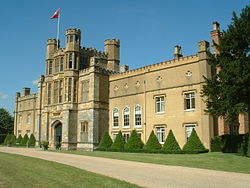Coughton Court
| Coughton Court | |
|
National Trust | |
|---|---|
 Coughton Court | |
| Grid reference: | SP080604 |
| Information | |
| Website: | coughtoncourt.co.uk |
Coughton Court is a Tudor country house, on the main road between Studley and Alcester in Warwickshire. It is a Grade I listed building.
The house has a long crenelated façade directly facing the main road, at the centre of which is the Tudor Gatehouse, dating from 1530, this has hexagonal turrets and oriel windows in the English Renaissance style. The gatehouse is the oldest part of the house and is flanked by later wings, in the Strawberry Hill Gothic style, popularised by Horace Walpole.
History
The Coughton estate has been owned by the Throckmorton family since 1409. The estate was acquired through marriage.[1] Coughton was rebuilt by Sir George Throckmorton, the first son of Sir Robert Throckmorton of Coughton Court by Catherine Marrow, daughter of William Marrow of London.[1] The great gatehouse at Coughton was dedicated to King Henry VIII by Throckmorton, a favorite of the King.[1] Throckmorton would become notorious due to his almost fatal involvement in the divorce between King Henry and his first wife Catherine of Aragon.[1] Throckmorton favoured the queen and was against the Reformation. Throckmorton spent most of his life rebuilding Coughton.[2] In 1549, when he was planning the windows in the great hall, he asked his son Nicholas to obtain from the heralds the correct tricking of the arms of his ancestors' wives and his own cousin (and niece by marriage Queen Catherine Parr).[2] (see gallery drawing) The costly recusancy of Robert Throckmorton and his heirs kept down later rebuilding, so that much of the house still stands largely as he left it.[2]
After Throckmorton's death in 1552, Coughton passed to his eldest son, Robert. Robert Throckmorton and his family were practicing Roman Catholics therefore the house at one time contained a priest hole, a hiding place for priests during the period when Roman priests were persecuted by law, after the Pope had called for the assassination of the Queen. The Hall holds a place in history for its roles in both the Throckmorton Plot of 1583 to murder Queen Elizabeth, and the Gunpowder Plot of 1605, although the Throckmorton family were themselves only indirectly implicated in the latter, when some of the Gunpowder conspirators rode directly there after the plot was discovered.
The house has been in the ownership of the National Trust since 1946. The family, however, hold a 300-year lease and manage the estate on behalf of the National Trust.
The house, which is open to the public all year round, is set in extensive grounds including a walled formal garden, a river and a lake.
Gallery
-
Coughton Court in the late 19th century.
-
Coughton Court, inner courtyard.
-
Coughton Court, gatehouse.
-
Coughton Court, facade.
-
Armorials depicted in windows of Coughton Court, as drawn by Wenceslaus Hollar(d.1677).
Outside links
- Coughton Court
- Coughton Court – National Trust information
References
- ↑ 1.0 1.1 1.2 1.3 Peter Marshall. Catholic Gentry in English Society: The Throckmortons of Coughton from Reformation to Emancipation, Ashgate Publishing, Ltd., Nov 17, 2009. Google eBook
- ↑ 2.0 2.1 2.2 The History of Parliament: the House of Commons 1509-1558, ed. S T Bindoff, 1982. Article: THROCKMORTON, Sir George (by 1489-1552), of Coughton, Warws.
- A History of the County of Warwick, Volume 3
- Coughton Court (1979) Booklet for National Trust by J Lees-Milne.
- "Six centuries in the same house". Daily Telegraph. 5 September 2009. http://www.telegraph.co.uk/comment/6138802/Six-centuries-in-the-same-house.html.




